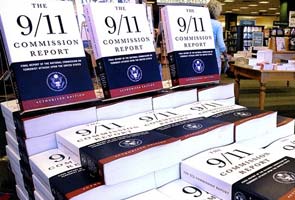CIA releases declassified documents from 9/11 file

Washington:NDTV: In the months before the terrorist attacks of September 2001, the CIA unit dedicated to hunting for Osama bin Laden complained that it was running out of money, and analysts considered the likelihood of catching the terror leader to be extremely low, according to government records published on Tuesday.
 The declassified documents, dated between 1992 and 2004, are heavily blacked out and offer little new information about what the US knew about the al-Qaida plot before 2001. Many of the files are cited in the 9/11 Commission report, published in 2004. The commission determined the failure that led to 9/11 was a lack of imagination, and US intelligence agencies did not connect the dots that could have prevented the attacks.
The declassified documents, dated between 1992 and 2004, are heavily blacked out and offer little new information about what the US knew about the al-Qaida plot before 2001. Many of the files are cited in the 9/11 Commission report, published in 2004. The commission determined the failure that led to 9/11 was a lack of imagination, and US intelligence agencies did not connect the dots that could have prevented the attacks.
Though few new details are revealed in the documents, the files offer more historical context for the years surrounding the deadliest terror attack on US soil.
The National Security Archive obtained the documents through a Freedom of Information Act request and published them on its website on Tuesday. The archive is a private group seeking transparency in government.
An April 2000 document from the CIA’s bin Laden unit alluded to a budgetary cash crunch that was cutting into the agency’s efforts to track the terror leader.
At that time, al-Qaida was a major concern to US intelligence agencies because of the 1998 US Embassy bombings in Kenya and Tanzania that killed many, including two CIA employees. Bin Laden had declared a holy war against the US, and the CIA had received multiple warnings that al-Qaida intended to strike the US
“Need forward movement on supplemental soonest,” said a heavily blacked-out document titled “Islamic Extremist Update.” The supplemental budget was still being reviewed by the national security council and White House Office of Management and Budget. Because of budgetary constraints, the bin Laden unit would move from an “offensive to defensive posture,” the document said. This meant that officials feared they would have to shelve some of their more elaborate proposals to track al-Qaida and instead rely on existing resources.
The “Uzbek Initiative,” referenced in the same document, was one of the more expensive programs the CIA ran at the time, according to a source familiar with the initiative. The program involved paying off CIA tipsters who monitored bin Laden followers traveling through Uzbekistan. The source spoke anonymously as a condition of describing the sensitive program.
The documents do not make clear whether the portion of the budget in question was passed. But they hint at complaints later detailed publicly after the 9/11 attacks by previous directors of the bin Laden unit that the Bush and Clinton administrations did not fully appreciate the severity of the threat, and as a result failed to fully fund their operations.
The documents also show that US officials were concerned that bin Laden was using Afghanistan’s national airline to carry in vast cash reserves when he was sheltered by the ruling Taliban mullahs in the late 1990s. The CIA’s “National Intelligence Daily” in June 1999 urged the imposition of sanctions on Ariana Airlines, then controlled by the Taliban, in order to put pressure on bin Laden’s cash flow. His cash flow reportedly depended heavily on flights from the United Arab Emirates into Afghanistan.
“Closing of Ariana’s UAE offices would force them to find alternative – and most likely less secure – carriers, routes and methods for moving bin Laden’s cash,” the document said. Later that year, the US and United Nations imposed harsh sanctions on Afghanistan and its airline, shutting down all flights and closing Ariana’s offices abroad.
The newly released files also offer details about the subsequent investigations into the attacks.
In one case, the US intelligence community investigated a link between one of the hijackers and the Iraqi Intelligence Service – a connection that was later proved false but that the White House used in its campaign to connect the attacks to Iraq.
According to a Dec. 8, 2001, CIA report that was sent to the White House Situation Room, the CIA had already made a preliminary determination that 9/11 hijacker Mohammed Atta had not in fact traveled to Prague in the Czech Republic in May 2000 to rendezvous with a senior official of the Iraqi Intelligence Service. Atta was an Egyptian national who piloted American Airlines Flight 11 into the World Trade Center. That he would have met with the IIS was significant for intelligence officials looking for a connection between al-Qaida and Iraq.
But just one day after the report was sent to the White House, Vice President Dick Cheney claimed on NBC’s “Meet the Press” that it had been “pretty confirmed” that Atta had gone to Prague several months before the attack. According to the 9/11 Commission report, it turned out to be a case of mistaken identity after a Pakistani with a similar name tried to get into the Czech Republic but was turned away. The document was the basis for a footnote in chapter seven of the 9/11 report.
Even though the information about Atta meeting with the ISS was later disproved, it still resonated with those bent on going to war with Iraq.
The hundreds of pages of CIA files released on Tuesday include a chronology of the agency’s efforts to catch bin Laden.
A March 2004 CIA report entitled, “The Rise of UBL and al-Qaida and the Intelligence Community Response,” discusses the likelihood of the CIA capturing bin Laden in the late 1990s using Afghans to do the job. Such a plan didn’t seem viable.
The CIA estimated that none of the available Afghan units had more than a 10 percent chance of capturing the heavily guarded bin Laden. Another option was using Ahmed Shah Massoud, leader of the Northern Alliance, who was friendly with the CIA and fighting the Taliban. “Even if he agreed to do so, his chances of success against the Taliban were judged to be less than 5 percent,” the report said. Al-Qaida operatives killed Massoud on Sept. 9, 2001.
President Bill Clinton was criticized for not doing more to catch bin Laden. But the documents show it wouldn’t have been an easy task, though some at the CIA were still hopeful they could get him.
“The odds of success are iffy,” Michael Scheuer, who ran the CIA’s bin Laden unit, said in a 1998 secret memo that was among the declassified documents released on Tuesday. “And the thing could blow up at any point along the way.”
It would take the US government another 13 years to catch and kill bin Laden.





